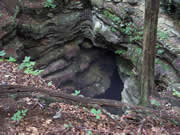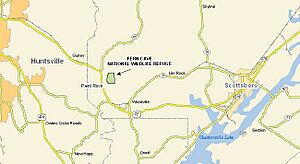Fern Cave National Wildlife Refuge facts for kids
Quick facts for kids Fern Cave National Wildlife Refuge |
|
|---|---|
|
IUCN Category IV (Habitat/Species Management Area)
|
|
| Location | Jackson County, Alabama, United States |
| Nearest city | Paint Rock, Alabama |
| Area | 199.23 acres (0.8 km2) |
| Established | 1981 |
| Visitors | 1,200 (in 2005) |
| Governing body | U.S. Fish and Wildlife Service |
| Website | Fern Cave NWR |
The Fern Cave National Wildlife Refuge is a special protected area in northeastern Alabama. It covers about 199-acre (0.8 km2) of land. This refuge is located near Paint Rock, Alabama in Jackson County.
More than 1,200 people visit the refuge each year. It does not have its own staff. Instead, it is managed by the Wheeler National Wildlife Refuge in Decatur, Alabama. The main cave itself is closed to visitors to protect its unique wildlife.
Contents
Exploring the Land: What Does Fern Cave Look Like?
Most of the Fern Cave National Wildlife Refuge is on the western side of Nat Mountain. This mountain is between the towns of Scottsboro and Huntsville, Alabama. The Paint Rock River flows along the northwestern edge of the refuge. This river is a branch of the Tennessee River.
The land here changes a lot. It goes from flat areas near the Paint Rock River valley to high points. The top of Nat Mountain is over 1,500 feet (457 meters) high.
Discovering Fern Cave: A Hidden World
Fern Cave National Wildlife Refuge gets its name from the many ferns found there. Early explorers discovered lots of ferns in a large hole called the Surprise Pit sinkhole. Another entrance once had a rare fern called the American Hart's-tongue fern. This fern is endangered, meaning it is at risk of disappearing forever.
Sadly, the fern population in the cave has almost vanished since 1985. This happened because people illegally took the plants. There is another small group of these ferns in Morgan County. That area is also closed off to protect the species.
Fern Cave is like a giant puzzle. It has many tunnels and deep pits. Explorers describe it as a "vertical and horizontal maze." There are 12 different levels inside the cave. These levels are connected by narrow canyons and deep holes. The cave is about 15 miles (24 km) long. It goes down about 450 feet (140 m) deep. The cave is very hard to get into. It can be dangerous even for experienced cave explorers.
There are five entrances to Fern Cave. Four of these entrances are inside the Fern Cave National Wildlife Refuge. The fifth entrance is owned by a group called the Southeastern Cave Conservancy.
Amazing Animals: Who Lives Here?
Fern Cave is home to the largest group of endangered gray bats in the United States. Officials believe that over 1.5 million gray bats use the cave every year. These bats are very important. Scientists have found a fungus in the cave that causes White nose syndrome. This disease is very harmful to bats.
About 200 different kinds of animals live in the refuge. Besides the endangered gray bats, the cave has other unique creatures. These include cave fish (like the Typhlichthys subterraneus), cave crayfish, banded sculpins, and cave salamanders (such as Eurycea lucifuga). You can also find northern slimy salamanders (Plethodon glutinosus) here.
Outside the cave, many other animals live in the refuge. These include white-tailed deer, wild turkeys, squirrels, opossums, raccoons, and rabbits. In the waters, you might see bluegill (Lepomis macrochirus) and yellow bullhead catfish (Ictalurus natalis).
Visiting the Refuge: What Can You Do?
The main Fern Cave is not open to the public. This rule helps protect the endangered bats that live inside. However, other parts of the refuge are open for visitors. The land is rugged, so it can be a bit challenging to explore.
Even though bats fly out of the cave every night to find food, the refuge suggests not watching them leave. The areas around the cave entrances are very steep. They can be dangerous, especially in the dark. Because of this, the park closes around dusk.
If you visit during the day, you can enjoy hiking. It's also a great place for photography. You can also spend time observing the amazing wildlife that lives in this special refuge.
Images for kids







